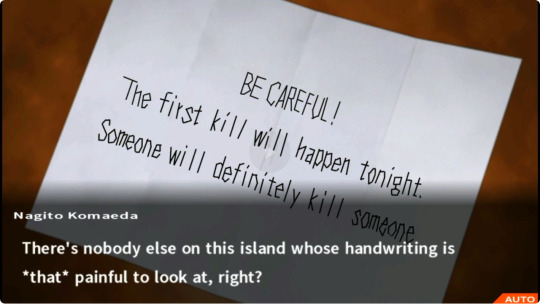#bvftd
Explore tagged Tumblr posts
Note
Somewhat related to your Komaeda autism post, but did you know that FTD can often be mistaken for mental disorders like depression, bipolar, OCD, autism, etc.? And vice versa? I always thought it was interesting and I like playing with the idea that Komaeda got misdiagnosed with FTD because of that overlap. Idk it's just fun to think about (also because a lot of typical FTD symptoms really don't match with him imo so it could be a fun explanation idk)
Disclaimer: I have zero expertise in this.
I was actually just discussing that with someone! I'm not sure that's possible, though? Because of his age I feel like it would have taken a lot of red flags (or a lucky coincidence) for doctors to consider dementia at all, and there's no way they wouldn't have confirmed it with brain scans. @cry-stars recently told me about a case in Japan where a guy in his 20s had dementia mistaken for depression for aaageees, so I could see him being the same.
So I could see him being misdiagnosed as something else- or correctly diagnosed with something he has on top of the FTD, attributing FTD symptoms to that- for years before having it corrected to FTD, or luck leading to brain scans/cognitive tests getting him diagnosed out of nowhere, but not the reverse of the former.
I still really love reading meta on potential comorbidities, though! On top of the post-traumatic stress there's no way he doesn't have. I've read some neat perspectives on him from people with OCD and BPD, but I don't have them myself so I can't add anything to those discussions.
#@ cry-stars pinged you in case you have more insight on this :0#imo bvFTD (combined with extreme post traumatic stress) tracks more for him than autism too after going through that icd list#part of the reason i did that was to look at the autism interpretation with the same strictness we usually apply to the FTD#like- he has FTD's social impairment/lack of filter/etc and rigid thinking patterns#without necessarily needing to have noticeable language or memory issues at this stage#and the latter is something he could be quietly compensating for#but i'll wait for the dementia metas and defer to those#anyway ty for the ask :D#kaoikentimesten#lyre gets interrogated#danganronpa#komaeda#komaedology
27 notes
·
View notes
Text
I know I shouldn’t get made when people make vague medical inaccuracies about something that I’ve never met another human who knows about it but like I dunno I’m still going to.
#nagito komaeda#this is about BvFTD#:(#I did so much research for it to be misunderstood by like everyone
2 notes
·
View notes
Text
Manicali has officially done more research on disorders in danganronpa than the creator of danganronpa
#BvFTD can only be truly diagnosed VIA post death autopsy. And it is FREQUENTLY misdiagnosed.#I am too big of a nerd for my own good but yeah#danganronpa#nagito komaeda#I also researched DID when I first saw Toko/Syo. because fact checking#EDIT: Manicali was wrong#So it can only be technically 100% confirmed as bvFTD until Autopsy#It can still be diagnosed#Apologies for spreading misinformation
2 notes
·
View notes
Text
Komaeda and Dementia: Part 1 of 5: Introduction and Overview of FTD

Hi everyone!
I’m an aspiring Komaedologist with an interest in dementia. I often see people doubting Komaeda’s stated diagnosis of frontotemporal dementia, since it presents differently in him than in the common portrayal of dementia in the media. While his portrayal may not be completely accurate, there is a lot of truth to it, and there are many symptoms visible in-game. I wanted to share a few posts about dementia symptoms that we do see canonically in Komaeda’s portrayals in SDR2 and DR:AE, and share some information regarding his specific diagnosis as opposed to Alzheimers, for example.
I work with people living with dementia as a recreation worker. This means that I see them living their daily lives, and know about difficulties they might have with recreational or day to day activities. There are a lot of observations that I might make that can’t be backed up scientifically yet, but do make sense in a practical way. Everyone with dementia is different, and since I work with seniors for the most part, some observations won’t transfer onto Komaeda. However, I’ll do my best to back up whatever I can with sources.
This post is just for fun and to give people ideas. It means a lot to me to see a fascinating and endearing character like Komaeda portrayed with dementia, since it is a sad and terminal disease, and I usually see it end badly in my job, so I hope to give people ideas on how to portray it, or just to notice things in a different way they might not have before!
My main sources for this post and the following ones include “Dementia Diaries,” which is a really cool project where people with dementia talk about their experiences, National Institute on Aging, Alzheimer’s Association, Alzheimer’s Society, and my own work experience. I plan on doing more posts about specific symptoms that we see in Komaeda later, but I would be happy to hear from other people who have dementia knowledge, or to answer any questions that I can.
For the most part, I'm only going to be talking about SDR2 and a little bit of DR:AE. I haven't finished watching the anime yet and have not read any of the manga. If anyone has ideas from any of those sources, I would love to hear about them!
Overview of FTD: Which Variant does Komaeda Have?

There are two major forms of frontotemporal dementia. The first, which Komaeda likely has, is the behavioural variant (BvFTD), which is also the most likely for young people to develop. This variant of FTD mainly affects behaviour, empathy, judgement, and planning.
Komaeda is less likely to have the other variant of FTD, primary progressive aphasia. This form of FTD mainly affects language skills, including speech and comprehension.
Komaeda doesn’t seem to have very much trouble with understanding the concrete content of what people say to him, but he does occasionally seem to have trouble fully comprehending hidden meanings behind statements (for example, taking statements literally rather than as sarcastic). To me though, this is less connected to him not being able to understand the words or content of statements, and more not picking up on the emotions hidden in the statements (which I’ll address more in the behavior post). He does seem to have some trouble with word-finding in the Japanese version of the game, but again, it doesn't inhibit his ability to express himself given enough time to speak.
Another thing to note about FTD is that, in its early stages, it mainly affects behaviour and language processing, as stated above, rather than memory. In later stages, memory does start to be affected as well, but it’s different from Alzheimers (probably the most well-known form of dementia) in that memory loss isn’t the main symptom.
FTD’s prognosis is about 6-8 years. Komaeda states in his fifth free time event that his life expectancy is between half a year and one year. However, he is also referring to his lymphoma diagnosis, meaning he expected to die from a combination of both illnesses within that time frame. In SDR2, Komaeda is probably in the early to middle stages of FTD, since he was diagnosed right before entering Hope’s Peak, and was a Remnant of Despair for some time without treatment, so while we can see evidence of memory issues (which I will address in another post), it’s something he’s able to cope with and isn’t a debilitating symptom yet.
One more observation: while dementia as a whole is usually seen in elderly people, Komaeda’s specific frontotemporal dementia diagnosis has an earlier age of onset, usually between ages 40-65, and is rarely seen in elderly people. Even though being diagnosed in high school seems unlikely, it is not impossible. According to Alzheimer Society Canada, early-onset or young-onset dementia (between ages 18 and 65) accounts for 2-8% of all dementia cases.
Thank you for reading! I plan on making five posts total. The other post topics will be Outward Behaviour, Judgement/Thought Processes, Other Symptoms, and Writing Ideas.
#nagito komaeda#danganronpa#sdr2#komaedology#danganronpa analysis#i'm really excited to do these#they might take me forever (even just this one took me a million years dfjkhfdfd)#but i hope they can be interesting or useful to someone#thank you to windcarvedlyre for the encouragement to post these#and for the help looking for sensory overstimulation moments in the game#i feel a bit shy tagging someone in the body of the post but i want to acknowledge you here hehe
122 notes
·
View notes
Note

ghdsfkjghdsf is that a common thing?
I don't really get how he'd be misdiagnosed anyway; it would need brain scans, especially since it's so rare at his age, and if anything it would have been misdiagnosed as other conditions for a while. Only going off cry-stars here- I have no expertise myself- but she's said that can happen and there was a recent case in Japan where a young guy's dementia was mistaken for depression for ages.
If we doubt Komaeda's FTD it can only be via doubting his honesty imo (but I still think he's telling the truth). I also love seeing analyses of him through the lenses of other disorders as comorbid instead of alternative diagnoses- especially autism, but I've seen interesting takes wrt OCD and BPD too- but canonically I feel like bvFTD, extreme post-traumatic stress and political radicalisation adequately explain his issues.
TO BE FAIR it probably isnt As common as i think it is, i just saw one reddit post thst explicitly claimed the FTD was a misdiagnosis and that it totally makes way more sense for komaeda to have autism and bpd, and a surprisung number of people... agreed? for some reason??
which i need to state for the record a) i am autistic myself and b) have absolutely zero problems with headcanons, even if they arent ones i ascribe to personally
what i DO have a problem with is people erasing canon neurodivergencies and/or erasing traits CENTRAL to a character in order to square-peg-round-hole the headcanon THEY have as the most correct one
"nagito has ftd and was autistic before that?" cool! neat! seeing how those two disorders being comorbid with each other could be really interesting!
"nagito does NOT have ftd, the devs were wrong, they actually wrote an autistic character and didnt realize it" stop talking.
this is very like, misanthropic i guess but after SO MUCH SHIT ive seen it just speaks to an unwillingness to empathize with or relate to anyone that isnt exactly like you. and you cant just headcanon real people around you with Misdiagnosed Autistic (most.... times....) so this pops up in fiction
like. i am autistic! i also have two (2) personality disorders, and neither is bpd. this has led to a non negligible amount of autistic people completely stereotyping my other disorders as evil in order to prop themselves up ("i thought i was a narcissist/sociopath, which wouldve been awful, but really i was just autistic! phew!!" with implicit, sometimes EXPLICIT value judgements being made)
i have had a friend i had in real life, to my face, say he didn't believe i had either personality disorder and really i was secretly just autistic
...if we had been better friends, maybe he would've known me well enough to know that that's almost... comically untrue. lol
so in my opinion there do exist a certain minority of autistic people who see autism as the only neurodivergency that Matters, or at least the one that matters the most. and the only way they can feel any sympathy for anyone else is if they are also autistic
and i know this is a minority! and i just see it a lot because i am an autist in fandom and a lot of other autistic people are also in fandom! AND that this is a mindset prone to ANY minority- most people think their Problem is the Worst Problem, it just... happens. however i am just as irrational and prone to biases as anyone else and ive chosen this as my completely irrelevant hill to die on
that one reddit post made me so goddamn mad bc of All This PLUS its double insulting when someone says "i have a special interest in psychology!" as a way to say theyre extremely knowledgable, and doing genuine analysis with the lens of "i am looking at the text and trying to make an objective diagnosis" and then STILL DO THIS!!! because they have this veneer of "im just a guy asking questions" before diving right into a weirdly consspiratory subset of "everyones an idiot about mental health except for ME"
...which tbf i dont think that about myself. i am very good at writing a wide variety of mental illness due to a combination of research and life experience BUT i could really only tell you like. actual non-surface level FACTS about aspd and to a lesser extent, npd. because thats what i chose to focus on. there are far and away lots more people that know more about me about other things, and im fine wit that
i am however also aware of this extremely hyperspecific social phenominon. and thus it is my burden to bear. my mountainous molehill.
also r/danganronpa just fucking sucks like in general. every time i see a kokichi opinion there i get a little closer to pulling the trigger. i think the real moral here is reddit is garbage and should not be used for anything other than product reviews
(also fwiw i agree w ur personal take at the end, with a lil bit of ocd tendencies that like, started off manageable and nowhere near diagnostic level badness, since things he might do to manage his cycle and even the constant thinking about it are very much reminiscent of obsessions and compulsions. but ftd in of itself can cause ocd symptoms so after that it got... worse. thats my personal take on it ^^)
#i do have like other experiences with this very specific phenominon#in the last fandom i was in someone tried Debating Me and saying my headcanon (about aspd) is dumb and amateur#and i dont know what im talking about#and the character is CLEARLY autistic#(because he was autistic and related to him)#he tried to do this three times on three seperate accounts#and i KNOWWW its a vocal minority but also i hate them#i dont think ALL autistic people are like this. or all autistic people who hc their faves as autistic#but the ones that ARE like this make me lose my fucking mind and then i go on my personal old man yells at cloud rant#also teehee we have the same name#ur komaeda lyre and im kamukura lyre#or komaeda lyre and kokichi lyre?#eegh whichevers funniest#uso janai ka?
17 notes
·
View notes
Text
sigh. was watching a let’s player go through komaeda’s FTEs and they said he was using his diagnosis as an excuse for his actions. “oh, i’m dying and insane so everything i do is justified” like — agH stfu!!! i’ll never claim komaeda’s actions to be good, and yeah i joke about his “insane”ness a lot, but at the end of the day you genuinely can’t hold him accountable. he is not in control of his facilities — FTD specifically targets your personality/behaviors — he is not in a right state of mind and is completely unaware he is in the wrong. he CANNOT COMPREHEND that. he’s just genuinely unable to!!! i’ll never claim he isn’t a bad person, or that he isn’t an antagonist, but at the end of the day he is someone who needs not help necessarily, but to be taken care of/looked after. he doesn’t belong in a prison, he belongs in a mental facility. where he can have trained professionals who can keep watch over him and actually work with him and keep him in check. — in any canon related verse he’ll never actually get that, esp given the state of the world, but it’s true that’s what he needs more than anything else.
and people really do tend to overlook just how much bvFTD truly fits komaeda as a diagnosis. especially in ways that aren’t touched upon by the vaaaaast majority of people. a while back i read a research paper about hyper-religiousity in patients with FTD; which could very easily be applied to the way he views hope. first clinging to it as a coping mechanism and that being exaggerated through the deterioration to become a blind faith that he is obsessed over which leads every action he takes.
anyway i just think it’s ridiculous to call a disease like FTD an “excuse.” there are people who use their mental illness as excuses for their actions to justify themselves, yes. but this isn’t a mental illness — it’s a degenerative brain disease. it’s an entirely different category. this isn’t a case of an illness making it difficult to control his actions and act reasonably, it’s a case of a disease making it IMPOSSIBLE to control his actions and act reasonably. it just really upsets me to see people brush that off because that is one of the main things that makes komaeda actually sympathetic.
#dementia tw#ftd tw#can you guys tell i have a special interest in mental illnesses/diseases and things that effect human behaviors#no?#damn.#— i could pop off about toko too but this blog ain’t about her#komaeda also fascinates me bc typically when i see any form of dementia in media it is like… the point of the character#it’s some tragedy— they become their illness— and the story is about people dealing with it#but komaeda… you may never even find out he has ftd#he’s just a fascinating character on his own#his story isn’t defined by his ftd but it is the thing behind so many of his behaviors#idk if i’m making sense it’s 4am but#god#i’m so passionate about this#♡₊˚ 🍀・₊✧ » ooc : post ─ 𝘏𝘖𝘓𝘋𝘌𝘙 𝘖𝘍 𝘒𝘖𝘔𝘈𝘌𝘋𝘈 𝘏𝘖𝘛 𝘛𝘈𝘒𝘌𝘚. ❞
11 notes
·
View notes
Text
Cerebrospinal fluid (CSF) circulates in and around the brain and spinal cord to help cushion them from injury. When this fluid leaks into the body, the brain can sag, causing dementia symptoms.
Chiari brain malformation, a condition in which brain tissue extends into the spinal canal. Brain sagging, Schievink said, is often mistaken for a Chiari malformation.
The reversible impairment of behavioral variant frontotemporal brain sagging syndrome: Challenges and opportunities.
Alzheimer's & Dementia: Translational Research & Clinical InterventionsVolume 8, Issue 1 e12367 published: 18 December 2022
https://alz-journals.onlinelibrary.wiley.com/doi/10.1002/trc2.12367
Due to loss of brain buoyancy, spontaneous spinal cerebrospinal fluid (CSF) leaks cause orthostatic headaches but also can cause symptoms indistinguishable from behavioral variant frontotemporal dementia (bvFTD) due to severe brain sagging (including the frontal and temporal lobes), as visualized on brain magnetic resonance imaging. However, the detection of these CSF leaks may require specialized spinal imaging techniques, such as digital subtraction myelography (DSM).
2 notes
·
View notes
Text
…
We are going to pretend I know how to read and didn’t explain bvftd for no reason
Okay?
Also I WISH? That would be so interesting. I wanna do a science…
#I’ve actually never ordered something online#I misread this with the poll above it#whoch was explain your hyper fixation to a medieval peasant#…#look its late
21K notes
·
View notes
Text

Game: Danganronpa 2: Goodbye Despair
Also there'll be images of self injury. Luckily the blood is pink, but heads up.
The first and obvious character I need to talk about here regarding this game is Nagito. This post will focus on him.
I'll begin by going straight to the point by taking some key info from his wiki page
Which says as follows regarding his condition: Nagito's Free-Time Events reveal that he was diagnosed with stage 3 malignant lymphoma and frontotemporal lobe dementia. While it is left ambiguous in the game, his illnesses and backstory are confirmed in the side materials as well as in his school profile in Danganronpa 3.
He appears to suffer from behavioral variant frontotemporal dementia (bvFTD), which symptoms may include changes in social and personal behavior, loss of insight into the behaviors of oneself and others, inappropriate social behavior, poor impulse control and judgement, apathy, loss of empathy, mental rigidity, repetitive compulsive behavior, a decline in self-care and personal hygiene, changes in food preferences, delusions, euphoria and lack of awareness of any thinking or behavior changes. Needless to say, this explains a good deal of Nagito's unethical behavior and emotional instability.
Other indications of his sickly state include his complexion, hair color, and breathy voice. In Island Mode, it's mentioned that he has poor stamina, very sensitive skin and he seems to dislike running. His character profiling describes his "pallid skin of the diseased" as well as his hair color, which "doesn't look like it belongs on a living person".
The Despair Disease had a much worse effect on Nagito than anyone else and almost killed him, presumably because he was already very ill.
Izuru Kamukura mentions that Nagito has a scent of someone who is "already finished", referring to the fact that he should already be dead, but his luck is keeping him alive. - Danganronpa wiki
Now that you've read all that. These in-game images begin to make a lot more sense


During a certain point in the game Nagito collapses after experiencing a sudden pain in his head (it's likely to be pain as he's clutching his head, or some kind of discomfort like dizziness and nausea) sweating profusely as the despair disease causes intense fevers. Since Nagito is already going through a lot with his body and brain, the immense heat is like another pressure on it. As if setting his entire body on fire.
This put him in a critical condition. Struggling to breathe as his already weak body is trying to fight the new illness (it could also be attacking itself) he even looks terribly ill as he's lying there in his hospital bed.
It's highly unknown how Mikan was able to stabilise him, on her own and without much equipment, despite being in a hospital. Even if she is the Ultimate Nurse. Even the best nurses wouldn't be able to stabilise such a condition alone in an environment like that. And especially with the kind of character she is We may never truly know....



Then again. When it comes to video games and medical. Nothing makes sense. I mean, walking up to a medikit after being brutally shot multiple times = fully restored!
Anyway, there's been multiple times where Nagito has been injured. However these were self inflicted due to his plans and questionable mindset.

It's a good thing they have alien blood. Because this is even beyond what most horror games can allow
Whilst he taped his mouth so that he couldn't scream from the shear pain, it's remarkable that he was still strong enough to do this. Even with how weak his body already was, and with the deep lacerations he already cut into his arm, he was still able to violently stab his legs without his other arm going limp from both the pain and blood loss. All the while his arm with the lacerations holding onto the cord which led to the spear suspended above him.
Even though Hajime and co worked to put out the fire and poisoned him, logically, Nagito should have died before that even happened. He would have been far too weak to even hold that cord, and passed out from both the pain and blood loss. That spear would have killed him anyway, poison or not. Even after stabbing his legs, he propped the knife and stabbed his hand through it. With his body THAT brutally cut up, by any normal circumstances his left hand should have relaxed as it went limp which would let go of the cord. Way before the group arrived.
But hey. Let's just blame Nagito's luck for this. He must have also been extremely determined and crazy to the point of nullifying the pain so that he was strong enough to do all of this. But that spear would have weighed a hell of a lot, and if you are injured and weak it would be a LOT heavier.
It wasn't just this insane mutilation he did. Because after the events of Goodbye Despair he severs his own left hand. And not in a sanitary way. Replacing it by attaching the dead hand of Junko (no idea how the HELL he got one of her body parts especially after her full body was CRUSHED to death)
Let's not even get started with how many medical complications there are here. From the potential blood poisoning to full on blood loss. This is why amputations should happen in a controlled and sterile environment should it be needed, like an operating theatre. The body is so sensitive that even if a tiny cut was to get infected, you'd be at severe risk of other complications that could shut down your organs. That's why you need to be extremely careful and not perform such procedures yourself. Please just let the medical professionals do that, IF you need an amputation in the first place, which would first need to be confirmed by the doctors.

And your body may not take too kindly to a new foreign object attached to it
It's bad enough when a body is getting used to a new heart transplant let alone a limb. It's like an entire army is inside of you, in the form of cells etc. which will start firing at anything it doesn't like. Damaging your body more in the process like a double edged blade.
Regardless. Let's move on to something more positive. Not really for Nagito as he's still in some health crisis situation.
But at least we have an adorable cradling moment here from the anime.

He isn't very impressed because It's not Hajime
And that moment where he was being tended to (yet again) by Mikan after his face was scratched up by a cat.

Because, as we know. Cats can be jerks.
youtube
Not like this cat though, this cat is the pinnacle of all evil
1 note
·
View note
Text
6 Debilitating Neurological Disorders and the Search for Potential Cures
This article discusses six neurological disorders which presently have no definite cure. Also, how AI is being used to find new treatments for these diseases. These disorders are Multiple Sclerosis (MS), Parkinson’s Disease (PD), Alzheimer’s Disease (AD), Frontotemporal Dementia (FTD), Migraine and Autism Spectrum Disorders (ASD).

Multiple sclerosis (MS) is a neurological disorder which affects the central nervous system (CNS). For a patient suffering from MS, their immune system attacks myelin (protective cover of nerve fibers) by mistake. It causes cognitive impairment, paralysis, numbness, blurred vision, coordination problems and fatigue. There is a serious need for new drug discovery approaches as there is no complete cure available. NeuroDiscovery AI is using artificial intelligence to make advances in helping to find cures for MS.
The company uses real world data (RWD) like EHRs (electronic health records) and treatment outcomes to analyze disease progression and treatment efficiency. Their AI platform analyzes huge medical datasets to help in patient recruitment and designing effective clinical trials. This assists biotech researchers and pharmaceutical companies to identify potential drug candidates. The platform collaborates with neurological care providers, academic institutions and life sciences companies to provide large patient datasets. It is leading to a complete transformation of the MS drug discovery process as artificial intelligence is continuously evolving.
Parkinson's disease (PD) is a progressive CNS disorder which largely affects movement. This occurs with the degeneration of nerve cells in substantia nigra (a part of the brain). These nerve cells create dopamine which is a neurotransmitter crucial for coordinated and smooth muscle movement. Patients go through symptoms like balance issues, slowness of movement, stiffness, tremors, sleep disturbances, cognitive decline, changes in speech and depression.
PD is supposed to be caused by trauma, environmental and genetic factors. The treatments for PD are limited to managing symptoms and improving the quality of life as there is no cure available for PD. NeuroDiscovery AI is on a mission to help in finding cures for PD with its extensive patient data and use of its AI platform.
Alzheimer’s disease (AD) is a neurodegenerative disease which impacts behavior, thinking and memory. AD is the most prevalent reason for dementia. AD starts with moderate memory loss which becomes worse gradually. This leads to cognitive impairment and decreases the patient's ability in carrying out day-to-day activities.
AD begins with symptoms like difficulties in learning new things, remembering recent events, confusion and memory loss. With its progression, patients experience mood swings, impaired judgment, trouble in speaking and disorientation. The patient loses the ability for basic communication, daily tasks and recognizing close ones. AD is supposed to be caused by lifestyle, environmental, genetic and age factors. At present, treatments for AD focus on managing symptoms, improving quality of life for patients and slowing disease progression. NeuroDiscovery AI envisions a world where AD can be stopped and even reversed.
Frontotemporal dementia (FTD) is a category of CNS disorders which affects the frontal and temporal lobes in the brain. This leads to changes in motor skills, personality and overall behavior in patients. There are three primary types of FTD, Behavioral variant FTD (bvFTD), Primary progressive aphasia (PPA) and FTD with movement disorders.
bvFTD is the degeneration in the frontal lobe which results in personality changes. PPA mainly affects a patient's language skills. PPA patients lose fluency in speaking, have problems in sentence forming and have difficulties in finding the correct words. FTD with movement disorders have motor symptoms like movement issues, tremors and stiffness which are similar to symptoms found in ALS (amyotrophic lateral sclerosis) and PD. We at NDAI are assisting life sciences companies in neuro research to find a cure for FTD.
Migraine is the most common CNS disorder which can be described by repeated headaches of different intensities. It impacts a patient's quality of life and daily activities. The other symptoms which follow migraine are auras (visual disturbances), nausea (urge to vomit), phonophobia (sensitivity to sound) and photophobia (sensitivity to light). Generally, a migraine attack advances in four phases, Prodrome, Aura, Headache and Postdrome. All patients may not experience all four phases.
Prodrome is the first phase occurring hours/days before headache which has symptoms like neck stiffness, mood swings, fatigue and food cravings. Aura has symptoms like flashing lights, blurred vision, tingling sensations and blind spots. Aura usually lasts for less than an hour. The headache phase has intense pain mostly on one side of the head which lasts between 4 hours to 3 days. This phase is also followed by symptoms like sensitivity to sound/light, nausea and vomiting. Postdrome is the last phase which lasts up to 2 days. The symptoms include fatigue, weakness, confusion and exhaustion. NDAI is working towards finding innovative cures for Migraine.
Autism Spectrum Disorder (ASD) is a neurological condition which impacts social interaction, behavior, communication ability, forming relationships and maintaining eye contact. Most often, ASD occurs by the early age of 2-3. ASD is believed to be caused by a combination of environmental and genetic factors. People with mild ASD symptoms lead independent lives. While others with major symptoms need support in daily tasks.
ASD is usually followed by symptoms like sensitivities to sound and light. This affects a person's daily life in a significant way. ASD treatment includes medical treatment, nutritional therapy, social skills training, school based therapies, occupational therapy, sensory integration therapy, behavioral therapy and cognitive therapy.
NeuroDiscovery AI is partnering with top healthcare providers, educational institutions, patient advocacy groups and life sciences companies to transform neurology with AI driven insights.

#multiple sclerosis#alzheimers#parkinson's disease#frontotemporal dementia#migraine#autism#asd#ftd#ai drug discovery
0 notes
Note
At this point, anything can be sexualized. Why do ya think Rule 34 is a thing?

Uh, wh-what...? Sorry but I don't think I look up those, it's really odd to me! I mostly watch horror and mystery anime!

But the doctors did tell me that hypersexual behavior might be apart of behavioral variant frontotemporal dementia and given my love for Ultimates, maybe that's why I love and idolize them?

Indeed and looking over your behavior I think we can safely assume that you get turn on by hope and talent then but they also indicate an increasing awareness of heightened sexual activity as a source of personal distress and functional impairment, and clarification of hypersexuality in bvFTD could contribute to understanding the neurobiology of this behavior.

Ah so that's why...

Well, thank you for explaining that then!
#dr#danganronpa#dtfa#despair to future arc#fs:rw#future side: re write#fs ep 11#sdr2#super danganronpa 2#nagito komeada#nagi nanami#anonymous
0 notes
Text


Rewatched part of ch1's trial and found something else that's really interesting in hindsight!
We're all familiar with Komaeda's FTE; over a decade later, there's still some room for debate wrt whether he was telling the truth about his diagnoses or not. My stance was already that he was telling the truth, instantly regretted it, and lied that he was lying, and I will die on that hill. I think the above lines reinforce my stance further.
Hear me out. I might as well make this a comprehensive 'Komaeda wasn't lying' post while I'm at it.
For reference, here's the entire final FTE.




The reasons I already had to believe him are as follows, ordered from strongest to weakest:
Komaeda almost died from despair disease; he was much more severely affected than Owari and Mioda. Lymphoma can weaken your immune system, leaving you more vulnerable to infections. While Komaeda's degree of illness could also have been due to bad luck, this could easily be an intentional hint about him.
He claims he's wanted someone's love all along. Again in chapter 3, after the trial, Tsumiki targets his lack of loved ones and seems to genuinely perturb him, indicating this is a real insecurity:






Behavioural variant frontotemporal dementia, or bvFTD, can have symptoms that align with a lot of his social and behavioural issues in the game. bvFTD symptoms can include saying socially inappropriate things/being rude and insensitive, rash/impulsive behaviour, empathy issues, and rigid thinking, among other things. Do I even need to cite examples of these? He can still hide things and manipulate people sometimes, but his ch4 investigation segment proves he's genuinely socially impaired. He sometimes fails to understand the emotional nuances of other people and the impact his words will have. For example:








(Though he still has moments of self-awareness and introspection; he acknowledges he's pessimistic in his introduction and worries he'll make Hinata hate him by saying weird things in Island Mode.)
Issues with memory, cognition in general, etc, are more of a thing in later stages of the disease, so Komaeda having significant social impairments but still being extremely sharp and lacking noticeable lapses in memory makes sense.
Physically Komaeda just doesn't seem healthy in general. He's pale, skinny, his hair is white (possibly fading into a pinkish brown that I could see being his hair colour in the past), and- at least in Japanese- he sounds really breathy and wheezy. I once laughed in a way uncannily similar to his ch1 breakdown when I had a chest infection. With asthma. Stage 3 lymphoma symptoms can include chest pain, shortness of breath, weight loss, loss of appetite and fatigue. If it's still stage 3 it's present in lymph nodes above and below the diaphragm but hasn't metastasized outside of the lymphatic system yet, but if it's advanced to stage 4 since his diagnosis then it may have spread to his lungs as well- having further potential to cause respiratory issues.
In his second-last FTE he starts to tell Hinata about something before he entered Hope's Peak but stops himself, not wanting to 'burden' Hinata. And leaves immediately to end the conversation. He'd just told Hinata how his parents died in front of him, showing zero awareness of how bad it was or how it would affect Hinata, so it must have been real bad for him to do this. And makes it less plausible he was impulsively repeating something from a book later, imo.

Iirc at least one spinoff manga runs with it being true, depicting him in a doctor's office during a nightmare. I'm too tired to hunt this down now; maybe I'll edit it in later.
On a meta level I just find it less compelling for the final reward for spending so much time with him to be 'Here's some actual vulnerability- lol psyche, remember he's manipulative? He might still want sympathy, you be the judge'. It would make the aborted confession at the end the only thing we can't infer from elsewhere in the game already. On the other hand, the diagnoses being real, and him trying to take it back and distract Hinata with an incitement to kill him (before also trying to confess his crush and aborting that too, he's a mess there), really really adds depth to his character.
Semi-tangentially, some people with bvFTD also develop neurological problems that affect movement- eg. making them slow and stiff. There's no evidence for or against Komaeda having this in canon afaik, and I've read it's more of a thing in later stages of the disease, but in the ch1 trial he talks about the threatening letter as if it's in his actual handwriting, and if so... it looks pretty stiff, doesn't it? Either it was angular on purpose or the writer has trouble with fluid hand movements. Let me know if he displays fine motor skills anywhere else, I guess.


The only real counterargument is that he's outlived the 6-12 months he was expected to, but:
The estimate is presumably from the cancer, which is treatable. FTD can take years and years, even 10+, to reach the later stages.
That's an estimate, not set in stone, and real people have survived after being told they have X months to live without supernatural luck.
In either case, it doesn't matter how dire the prognosis is if Komaeda's involved. If the chance of him surviving something isn't zero it will probably happen. When he finally managed to kill himself it wasn't even real.
Anyway, the thing I started the post with! Compare the lines below.



In both cases he's said something that could make others feel bad for him, immediately takes it back, and claims he did that on purpose.
But he wasn't actually lying in the first line, albeit hamming it up a little. He wanted someone to kill him. This happened while he was still pretending to be the killer, after Saionji asked him why he sent the letter. He dropped a hint about the truth and then deflected away from it, likely intentionally antagonising people to distract them from thinking too hard about what he just implied and make them more averse to empathising with him.
So what could that imply about the lines from his FTE?
TL;DR: He told the truth about having cancer and dementia, your honour. There's not only strong evidence for this but precedent for the sort of deflection he made afterwards.
#danganronpa#dr2#sdr2#komaeda#nagito komaeda#dr analysis#you think you've seen my komaeda brainrot in its entirety? FOOLS.#god i spent ages on this i hope it's coherent lmao#inb4 kodaka's been like 'yeah he has them' since and this entire post is pointless haha#edited this to rearrange something forgive me if it breaks some formatting#komaedology
107 notes
·
View notes
Text
Post nwp my beloved
I love post nwp
I live partially in part to post nwp fics
I just love seeing what the remnants do.
#I also live in heavy post nwp headcanons#Headcanon one: Nagito is alive#He will not be dyijg#BvFTD means nothing to me in post nwp#(I accidentally read an angst fic once where he did and I wasn’t right for a month)#post nwp#new world program#danganronpa#sdr2
4 notes
·
View notes
Text
there is pain. a lot of it. i chose to read a scientific article about late stage bvFTD and there us emotional pain like no other.
#my therapist has been emphasizing to me that my coping mechanisms exist to protect me#and yeah im going to use those now.#unfortunately its difficult to heal wounds when being actively stabbed#percy2.0
0 notes
Text
#dementia tw#ftd tw#i’ve been doing too much research NOT to pop off. uhh just reply to this post if you wanna vote for more than one#if you say all i will knife you tho smh#i wanna get all of these one day i just need to start somewhere
7 notes
·
View notes
Note
I would instantly die. Like Id swap, realize i grew a lot, and then instantly drop dead from serious injury infections, Cancer, and bvFTD
Unless it’s pre servant. Then ignore the infections.
if you could swap bodies with your favorite character for probably your entire life, would you?
294 notes
·
View notes